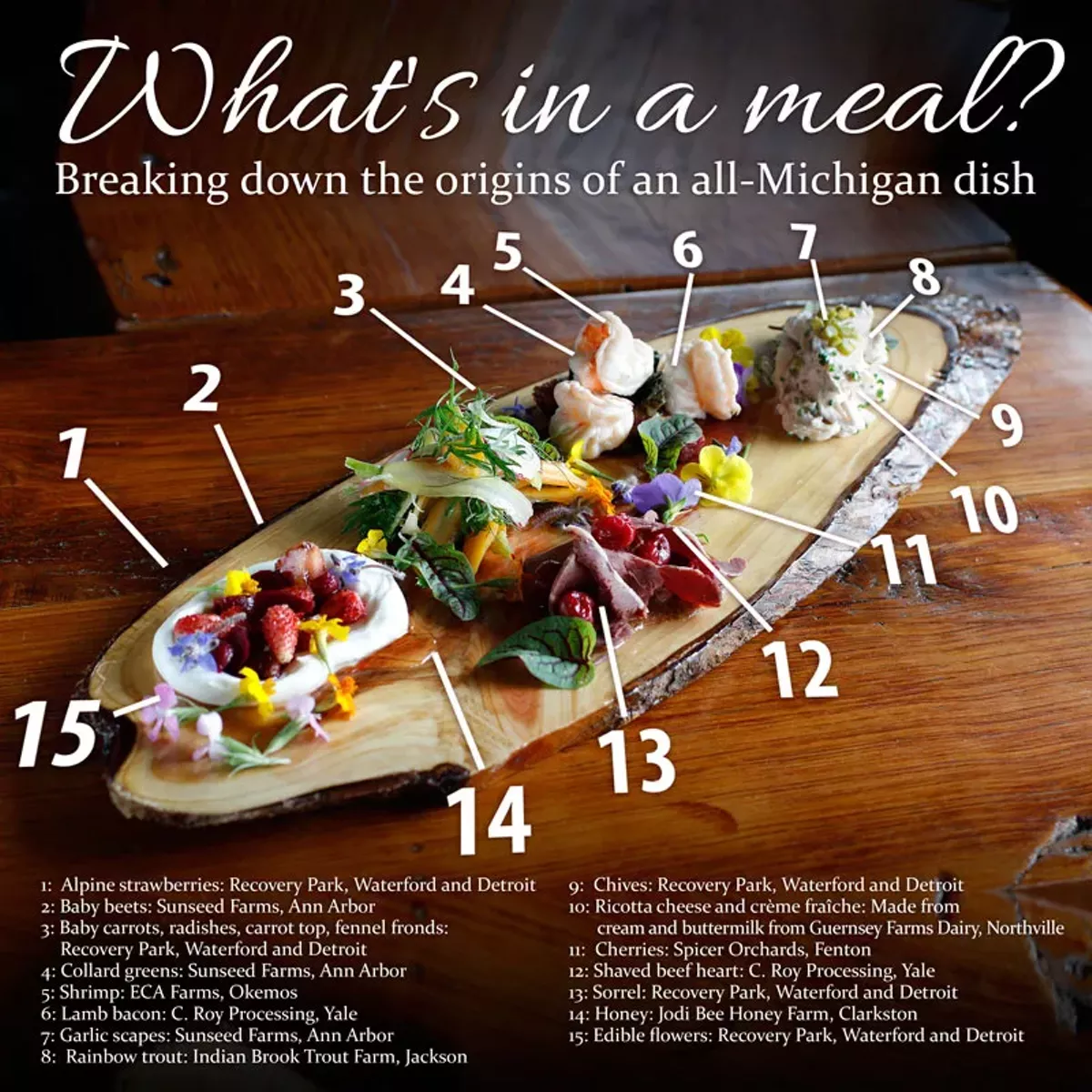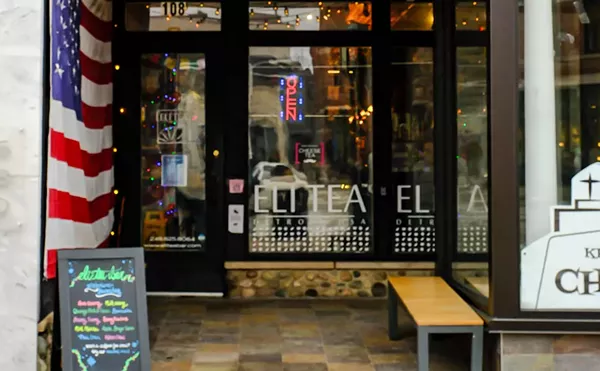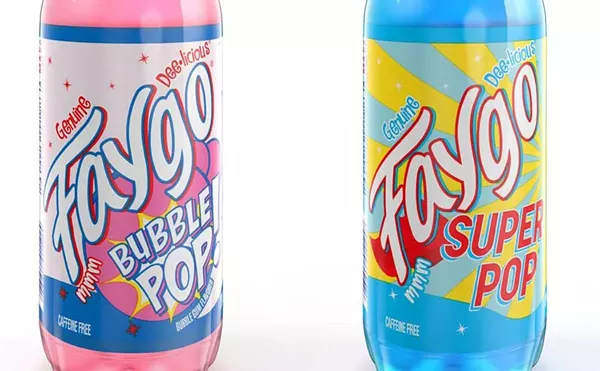On a June afternoon, the day shift is moving into the kitchen at the Root, the locavore restaurant run by chef James Rigato in White Lake Township. The space presents quite a contrast from the restaurant's elegant dining room. Music begins to pulse from the sound system as Rigato starts gathering his materials. He's listening to Amos Lee to calm him down. Rigato cracks, "I used to be all, like, DMX in my younger years, but now I'd rather not take Xanax. So I'll just take Amos Lee."
Rigato has met us here today to create a dish that's sourced as locally as possible, something that's his specialty. Surveying the ingredients, Rigato says, "We've got a lot of local shit here."
Over the course of 15 minutes, Rigato prepares what he calls a Michigan charcuterie board. It's like several small plates in one dish, mounds of food and condiments presenting a riot of flavors, all meant to be enjoyed with a bottle of wine over the course of a half-hour. There are tender bits of smoked rainbow trout tossed with ricotta, chives, and pickled garlic scapes. Shaved beef hearts enfolding pre-Prohibition-style Maraschino cherries atop a coffee-cherry mustard. Southern-style greens made with lamb bacon, heaped with pickled shrimp. Fresh and pickled carrots intermingled with fennel fronds and delicate sorrel leaves. Alpine strawberries mixed with baby beets pickled in balsamic vinegar. For good measure, the whole dish is drizzled with honey and strewn with edible flowers. It's all presented on a board from a tree — the bark still on it — but finely sanded down and given a protective glaze by a Michigan artisan.
Rigato's dish dazzles the eye, to say nothing of the palate. And yet the most impressive thing about it might be the fact that it's sourced almost 100 percent from Michigan, specifically from that broad farm belt running from the outer reaches of metro Detroit to Kalamazoo. Rigato cultivates relationships with the people who give him his basic ingredients, and does everything else in-house, including smoking, making cheeses, pickling, and cutting bacon — as he says, "no compromises."
Of course, not every ingredient can be from Michigan. The skosh of olive oil Rigato adds to the pickling juice to create the dressing for his little carrot salad can't be made here. But pretty much everything else is, down to the mustard, flavored with real coffee beans from Kalamazoo's Water Street Coffee, a microroastery that specializes in single-origins coffees and works with micro-farmers who use sustainable practices.
He may not be able to rattle off the Latin names of his ingredients like some chefs can, but he knows where every item on the plate came from, and has a human relationship with the people who made it. So we set about to get to know them too, to provide a snapshot of the people driving Michigan's local food movement.
We found an unusual mix of the traditional and the forward-looking, from established family businesses spanning generations to small-scale producers who fuss over every detail to exciting, next-generation stuff: growers who raise their crops in the city and men who farm fish up on land. One thing they all share in common is they're doing what they love to do, and they're proud of it.
The meat packers
The raw material for Rigato's shaved beef hearts and lamb bacon came from C. Roy Processing, located in the small town of Yale, up in the Thumb. Known to the many locals as "the bologna factory" — as it's the home of Yale Bologna — the family business was founded in 1924. Nancy Roy, 68, is the daughter-in-law and niece of two of the founders. She now runs the business with her husband Dick, and her daughter and son-in-law, Jennifer and Brian Lossing.
Of course, it's more than a "bologna factory." It's a slaughterhouse, meat packer, and butcher shop. It's also one of the few USDA plants left in the state that brings in live animals, and has them slaughtered, cut, and wrapped ready for the freezer with the USDA stamp on it. The business model is simple: As Nancy puts it, "The local farmers raise our animals, and we bring them in and slaughter them and package them for our local customers."
But C. Roy is picky about its meats. The factory is certified for grass-fed, organic, and traditional meat products. That means the farmers producing the livestock have to be certified as organic or antibiotic-free.
Luckily, the country around Detroit still has its fair share of farms raising animals the old-fashioned way, far from the smelly, "concentrated animal feeding operations" that crowd the Midwest. "There are no feed lots in our area," Nancy says. "So that's one of the nice things. These animals have lots of room to roam, and they are given enough communication with a human being that they come to you not completely wild."
It's the way C. Roy has always done things, pulling in traditionally raised livestock from the countryside, though the radius is expanding as older farmers age out of the business. These days, that wider arc runs as far south as Monroe County, as far west as Ann Arbor, and as far north as Snover.
While there would likely be greater profits in many other businesses, the family sticks with the processing plant. Asked why, Nancy calls it "foolish pride."
She says, "We aren't doing it for the money, obviously, yet it has been a good life. But we do it for the pride of what we're here with."
The beekeepers
Remember that honey Rigato drizzled over the dish? It comes from the honey house of Judy and Lloyd Schmaltz in Clarkston. The couple began beekeeping as a hobby around 1979. Judy says, "We started off with three hives, and we filled up honey bears and we took them to where Lloyd worked and — zoop — they were gone. So we got a few more hives, and then a few more hives, and pretty soon we were up to a couple hundred. Now we're running 125."
If that seems like a whole lot of hives, Judy is quick to differ. "If you're a big commercial beekeeper you have 1,000 hives, but they don't do what I do. Large commercial beekeepers will wholesale their honey to anybody who wants to buy it and pack it up in volume. Being that we're small and my husband has a real job so that I can do what I want to do, we don't have to worry about putting food on the table."
The work of making honey products happens right on the Schmaltzes' property, in a certified honey house out back. Under the label Jodi Bee Honey Farm, they produce comb honey, raw honey, and creamed honeys. They even produce varietal honeys, in which the essence of the predominant blossom the bees fed on comes through in the flavor. It's a tricky business to get bees to all feast on the same flowers, but the couple scours the countryside for locations.
Judy tells us, "You see if there are a lot of a particular flower that blooms there at a certain time, and then you ask somebody in that area if you can put beehives out there. And out where we live, people are quite happy to have beehives. They like nature."
Lloyd says, "We have nine different locations. I used to put about 10 to 20 hives at each location depending on flower source. Bees will travel a mile or so to get honey, but the further they fly, the less honey you're going to get — they use a lot of energy. So you locate the hives in the center of about a quarter-mile radius where you've got your flowers. Out here in Ortonville, we have a lot of open land, and there's just a lot of flowers at various times in the year. Right now, we have a flower that's blooming that's called a star thistle. Technically it's Russian spotted knapweed, and that produces a very nice, mild honey. That's in bloom right now, so the bees are really darting in and out collecting that."
Talking to Judy and Lloyd, you get the sense they really care about what they do. Not just profits or losses, or just about harmful insecticides and parasitic mites, but about whether their bees are getting the nutrition they need, or whether they have enough blossoms to enjoy. Lloyd says, "I've had fields of full of alfalfa, except the people who raise alfalfa like to cut it during the bloom, and that's kind of rough on the bees. ... I had one yard at an apple orchard out here, and the bees love it. But it only lasts about two or three weeks, and so there has to be something after the apples bloom, and you have to worry about after because that's gonna be a short time."
Judy says, "The best thing you can do for a bee hive is pretty much leave it be. Don't go in too much. Don't truck them all over the country."
The trout farmer
Rigato's trout come from land, not sea. Specifically, they come from a partially wooded 90-acre farm of rolling hills outside Jackson. It's where Indian Brook merges with the Sandstone Creek, before the waters run on to the Grand River. It's Indian Brook Trout Farm, where president Owen Ballow, 55, is on the cutting edge of aquaculture.
Though the farm has only been open for 14 months, Ballow has a million rainbow trout in the water right now — not a figurative million but an actual amount — and is only at 10 percent of his capacity. Once the fish grow larger, the operation could harvest about 750 tons of fish a year. And the fish can't grow fast enough. Ballow says, "We're struggling. We run out of fish at the end of every month."
What makes Indian Brook so special is the water for the fish comes right out of the largest fresh water aquifer in Michigan, which runs 180 feet below the surface of his property. In fact, the farm is right by the Absopure bottling plant, which is there for the same reason. Ballow says he looked for a site like this for eight years, and had the good fortune to meet a hydrogeologist who gave him tips on where these underground streams are. The water flows out of the ground and into the trout farm's tanks without any pumping — 3.2 million gallons a day of it.
The free-flowing water not only helps reduce the farm's carbon footprint, but provides finicky rainbow trout with the high quality of water they need. Also, since the water comes up from below the frost line, it doesn't change temperature with the seasons, which is a setback for fish farms fed with rivers or creeks. Ballow says, "In the winter, when the water is in the 40s, the fish don't grow, they don't eat, they sort of hibernate. But because our water is coming out of the ground, it's 51 degrees year-round. So the fish grow in a year and are ready for market. In a lot of other places, it takes about a year-and-a-half."
And after the water has gone from ground to tank, the farm lets the water go back downstream. Far from being a waste product, Ballow says the water "recharges the drinking water table, so everyone downstream of us gets better drinking water."
The fish are hatched in a few indoor structures on the property. (Ballow says the fish don't do well out in the open at first: "Until they're about 5 or 6 inches they're just really skittish and afraid of everything.") Outside, grown fish are transferred to long narrow ponds lined with food-grade material, which makes it easy to vacuum up fish waste for fertilizer. But the majority of Ballow's fish are raised in 30-foot diameter round tanks that have circular water flow. Even that is designed to the fish farmer's advantage: Ballow says, "On the outside of the circle is where the greatest current is, so while the fish are eating they're working the hardest. As they get full, they sort of float back to the middle where there's less current, so they're not burning all their energy up trying to keep into the current."
He adds, "We're going to have 80 of those tanks when we're done with construction, so we'll rear specific groups of fish for specific customers. Some customers like bigger fish, some like smaller fish."
Right now, the fish get feed that's more mostly plant-based, with about 10 percent fish meal, but researchers have developed a soybean that fish can break down. The achievement of raising vegetarian fish may not mean much to diners, but it's an innovation Ballow says will allow him to get all his feed from within the state. He says he planted a test crop of the non-GMO soybean in Saline last year and it thrived.
The aquaculture pioneer
Rigato's shrimp come from another aquaculture trailblazer. His name is Russ Allen, 67, and his shrimp farm, Environmental Conscious Aquaculture, aka ECA Farms, is located in a 5,000-square-foot pole barn he built behind his house in Okemos. He calls it his "R&D building," since he's been researching processes to farm shrimp domestically in a way that is "environmentally stable and biosecure" — and make it competitive with overseas shrimp farms.
Those foreign shrimp farms are something Allen knows a thing or two about. He spent more than 20 years in Central America helping build the aquaculture industry in that part of the world. He says, "I was one of the pioneers of the worldwide shrimp industry in Ecuador, pretty much one of the few guys that helped get it started back in the '70s. After 10 years in Ecuador, I went to Belize and built the first shrimp farm in Belize." He has worked in Honduras, Nicaragua, and Guatemala as well. In Ecuador alone, he built about 4,000 acres' worth of shrimp ponds.
But Allen has spent more than 20 years trying to find a way to farm shrimp that is as large scale as the operations he helped build while being environmentally responsible. He says, "I started out with a garage-sized thing to address all the initial parameters: finding the right species of shrimp, the right feeds, the right stocking densities, the right temperatures and salinities. ... My goal was to do it all indoors, with 100 percent recirculating water, and no effluents coming out of the system at all."
By "effluents," Allen means shrimp waste. And though it can be harnessed, doing so is an added cost other fish farmers don't face. He says, "When you're competing with wild fisheries in countries where there's no EPA, they don't treat their effluents and it just goes out into the oceans, lakes, rivers of the world. But we can't do that here."
With the appropriate backing, Allen says he could expand his system and make it commercially viable. But he remains a craft producer for now, churning out a mere 400 pounds a week, all of which is snapped up by Eat Naturally, an Ann Arbor company that distributes his shrimp to local chefs willing to pay dearly for Allen's bounty. Allen says, "I've got to charge a fairly high price for me to keep doing it. But if we can get that capital and we can go to a commercial size, by my calculation, we can grow shrimp cheaper than anywhere else in the world, right here in Michigan."
If that doesn't sound like a big deal, Allen points out that aquaculture has been the fastest-growing sector of agriculture worldwide for many years, and that the United States imports about 1.4 billion pounds of shrimp a year. Allen calls it "the biggest trade deficit in the food industry."
If the shrimp farmer can close his funding gap, he says he'd be able to grow millions of shrimp, and he and his wife have just bought 100 acres up around Manistee where he intends to develop the commercial project.
The sustainable farmers
Some of the produce in Rigato's dish comes from Sunseed Farm, a little bit of the country located on Boyden Drive in Ann Arbor. In addition to vegetable fields, the farm sports several hoop houses, most of them 3,000 square feet or larger, where the food can be grown all the way through winter. In good weather, it's often a bucolic scene, with dogs running around and even a few small goats browsing contentedly.
Co-founder Tomm Becker, 32, studied English literature at Michigan State University, but the farming bug bit him when he worked at a farm one summer outside Lansing. He soon picked up a job Michigan State's student organic farm, and worked as the production manager there for a few years. Now he and his wife live in Ann Arbor, where he's pursuing his dream of running a small farm and doing community-supported agriculture.
Of small farming, Becker says, "It's a great livelihood. It's the kind of job where you can use all different parts of your brain. I get to be a horticulturalist, but I also get to be an ecologist and a mechanic, and a carpenter and a manager and an accountant — sort of everything, and everything in between. It's a pretty good way to make a living, I think."
And make a living they do. What's more, all employees are paid a living wage. Becker says, "We want to hire good people, we want to attract the best, and we want to get by with a small, sort of elite squad of people. We've made a commitment to always be putting positive pressure on farm wages in our area, both in an effort to attract the best of people and just to sort of change the paradigm of farm labor."
What makes it work, of course, is having customers who'll pay more for quality, such as restaurants. Becker says, "We found a great group of clients, a bunch of families here in Ann Arbor and a bunch of restaurants who are willing to do business that way. ... On a regular basis we are working with the Root, Bacco Ristorante in Southfield, Chartreuse, Selden Standard, Zingerman's Deli, and the Grange, among others."
Sometimes, these clients will work with Sunseed Farm on a "declining balance system," in which the farm is paid upfront for a year's worth of produce. "So instead of us having to front-load all the expenses of producing their food for them," Becker says, "they sort of enter into a shared-risk situation with us. ... We can offer them a little bit more priority when it comes to accessing our product, and then just make sure that they get the good stuff."
These sorts of novel arrangements aren't uncommon among those fostering Michigan's local food economy, in which clients clamor for this week's batch of aquaculture shrimp or a homeowner's honey. Economically speaking, local food economies really punch above their weight, and Becker is eloquent on this point. He says, "Local economies do a lot for themselves. Food being sort of the basic need of us all, it's a great place to start when you look at building local economies. Just here in Washtenaw County, there's about a billion dollars worth of food that's purchased every year. You can imagine what would happen if we kept, say, 10 percent of that here in Washtenaw County, how that would change our local food system and our local economy. ... Then there's the environmental impact of 'food miles,' of buying food from California or from other places. When you're purchasing food locally, you have the ability to make a more informed decision about how you're investing your food dollars."
That concern about the environment is part of the farm's mission. Becker says that, though Sunseed isn't certified organic, it adheres to strictly organic practices. "We don't use any synthetic pesticides or highly toxic or persistent pesticides," he says. "They're naturally derived. And we're really careful with how we use those, just in keeping with our greater mission of stewarding the farm ecosystem that we have."
The farm may stick to only the best practices, paying employees well, avoiding deadly pesticides, using heirloom and non-GMO seeds, and building healthy soil, but what Becker says sets his produce apart is that it's picked fresh and rushed to the user. He says, "The stuff that you're getting from the grocery store is probably gonna be at least a week old, and it's been handled along the way — so it's been in a truck, it's been in the coolers, it's changed hands a couple times, and it takes its toll. Leaves live on plants, and when you take them off the plant, they don't last super long. They're gonna lose a lot of their flavor."
The milk makers
The buttermilk and cream Rigato uses to make crème fraiche and ricotta comes from Guernsey Farms Dairy, located a couple miles down the road from Twelve Oaks Mall in Northville. When it was founded in 1940, it was out in the country. Now it's surrounded by sprawl. What visitors will find is a modern building in a suburb. Despite the name, there are no farms at Guernsey. But the milk comes from all around. Guernsey purchases its milk through a co-op run by the National Farmers Organization, and the milk comes from about seven small farmers in areas including Lansing, St. Johns, and Byron.
Manager Colleen Ortman laughs and tells us, "There aren't any cows here. But it's a very large building and all the processes are done here. We have ginormous freezers and coolers. Also we have a nice quaint little restaurant that's old-fashioned and family oriented. We have an ice cream parlor with 48 to 50 flavors to choose from."
Ortman says, "We have a longstanding relationship with the farmers we deal with. There aren't really many left in Michigan. There are no growth hormones in any of our milk. It is all RBST-free. That's important and that's something we've done for many years now. "
Like C. Roy, Guernsey is a kind of throwback to an earlier time. Co-owner Marty McGuire, one of the founder's sons, says the farmers Guernsey works with are traditional family farms that treat animals as more than milk-producing machines. He says, "Their cows are like part of their family."
McGuire adds, "I guess you would call us a craft dairy. We try to do the best we can and work with all the old formulas my dad created back when he went to Michigan Agriculture College and wrote up the formulas. We still use the basic formulas he created back then."
The fruit growers
The cherries in Rigato's dish come from Spicer Orchards, a family orchard owned and operated by Alan and Wanda Spicer since the late 1960s. It sprawls over the four corners of Clyde and Heartland roads in Fenton, encompassing almost 400 acres, producing strawberries, raspberries, peaches, plums, blueberries, pears, apples, pumpkins, and cherries. The U-pick orchard is close enough to the city to have ready customers, and far away enough to still be firmly planted in the country.
Crop manager Will Cartwright, 43, has worked for the Spicers since he was a teenager. He's known Rigato since before the chef opened the Root. Cartwright says Spicer provides much more than the Rainier cherries Rigato transforms into Maraschinos. Cartwright says, "When James places an order, we get it fresh-picked that morning and we get it up to him. I mean, he'll prepare a dish with fruit that's only maybe been picked for a few hours."
Spicer sets a high standard for its agricultural practices, even if, again, it isn't a certified organic enterprise. The farm uses integrated pest management, utilizing insect traps and trained scouts to look for problems before they start, responding with reduced-risk, consumer-friendly chemicals as a last resort.
Cartwright says, "We'll only spray if there's going to be an economic loss. We can bear some damage, but if it gets beyond the point to where we're going to lose too much, then we have to put a control on, which, to be honest with you, is very little. ... The fruit very rarely gets sprayed — only if there's disease or pest pressure that was provided by Mother Nature that we have to control. But we're real good and careful about that."
And even if losses loom, they seldom affect more than one crop. The wide range of crops at Spicer Orchards helps keep those losses to a minimum, and a bumper crop can tilt that balance.
That said, Cartwright doesn't seem like the kind of guy to dwell on dollars and cents. Asked how business is, he sounds like somebody from another century: "There's three families that work on the farm. We all work hard to make sure business is always growing, and we're trying to do the right thing. Business is good, so I think that, in a way, reflects our work and pride in our business."
The greenhouse farmer
Just off Scott Lake Road in Waterford, yards away from the whizzing traffic of the road, there's a kind of rural retreat. Next to a decaying barn sits a complex of greenhouses, where whirring fans circulate air above about 50,000 plants. The rear of the property abuts Waterford Oaks County Park, providing a horizon of low, rolling, forested hills. It's the kind of place that can feel much farther out in the country than it really is.
The greenhouses are the temporary home of Recovery Park, a small farm furnishing produce for such restaurants as Chartreuse, the Root, Selden Standard, Republic, Gold Cash Gold, Bacco Ristorante, and Townhouse. This list of hip clients is no coincidence: The enterprise is run by Michelle Lutz, the kind of grower who'll sit down and chat with a chef over a seed catalog before planting.
In fact, right now she's harvesting produce for a local chef, using a pair of needlenose shears to gather pods from a bed of wasabi arugula that has gone to seed. She offers a seed pod for tasting, warning, "This will light your mouth off. I tested them out with a chef I worked with and he's in love with them. That is one thing that is really neat about what's happening with our food culture. All of a sudden, the Detroit area is lit up with chefs that are willing to use the unusual."
It's welcome news to Lutz, who caters to a culinary trade by growing lesser-known heirloom edibles. She says, "Chefs may not use a high volume of produce, but the stuff they care for is really specialty. That's where the price point comes in. Maybe you don't have to grow hundreds of pounds of something. You can have a smaller amount and do a pretty fine job, financially."
In fact, Recovery Park was just picked up by one of the largest produce distributors in Michigan, a family-owned operation that serves more than 400 restaurants in the state. And Lutz doesn't grow just produce for chefs, but crops of edible flowers as well: The blossoms include nasturtium, dianthus, Mexican marigold, and viola. But she warns, "Just because they are edible doesn't always mean they'll taste good," before adding with a smile, "I do try to stick with edibles that I think actually taste good."
The enterprise has moved around a bit. Its ongoing intention is to be an urban farm helping build careers for people with barriers to employment. Last year, it was at 2600 E. Grand Blvd., where Lutz built raised beds and put up a 4,000-square-foot high-tunnel greenhouse in a parking lot. The pilot project was successful, and Lutz needed to expand. While a 110-acre land deal with the city is pending, Lutz is working out of Waterford. She says, "We've been growing here since the beginning of January and we've actually sold products in February. It's been a nice little space for us." Lutz plans to move the business back to Detroit in October, and to personally move to the city as well.
And Detroit in 2016 may be the perfect time and place for Lutz and her business, with the rising value of local, fresh, sustainably grown food. Lutz doesn't mince words, saying, "If you would've tried this 10 years ago, you would've been shit on. I remember struggling so hard growing organic food. ... It was painful how long it took for stores, for anyone to catch on, but I knew it would.
"Agriculture has always been a great thing for Michigan. It's the second-leading industry. But we don't treat it like one. We are still too comfortable with watching our food get brought in."







